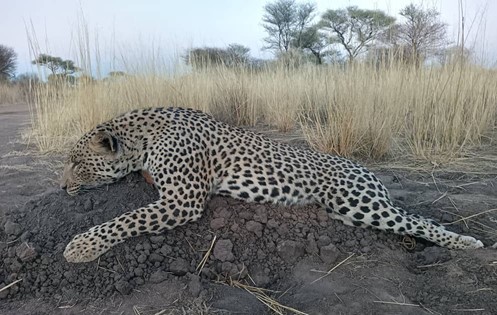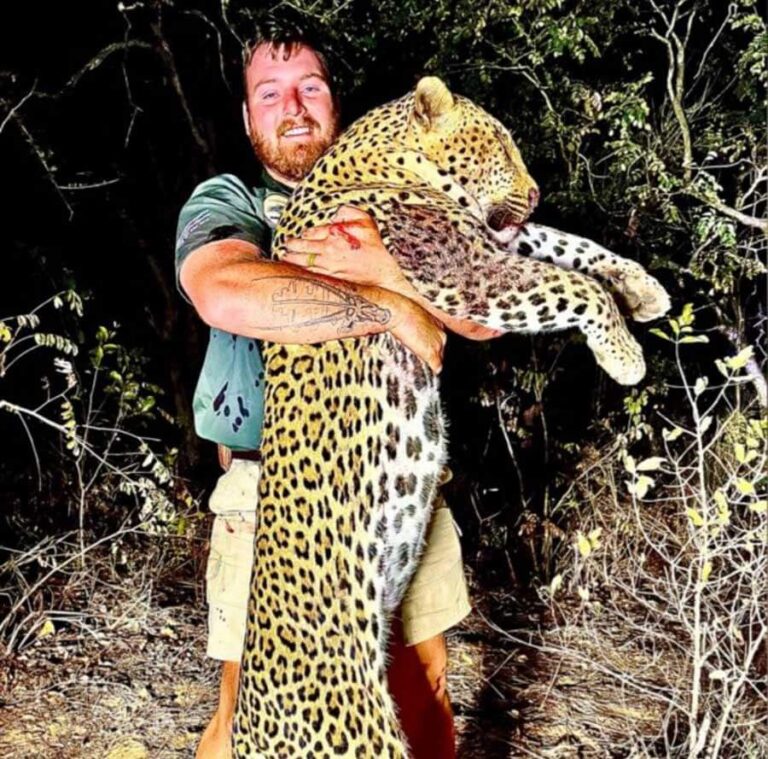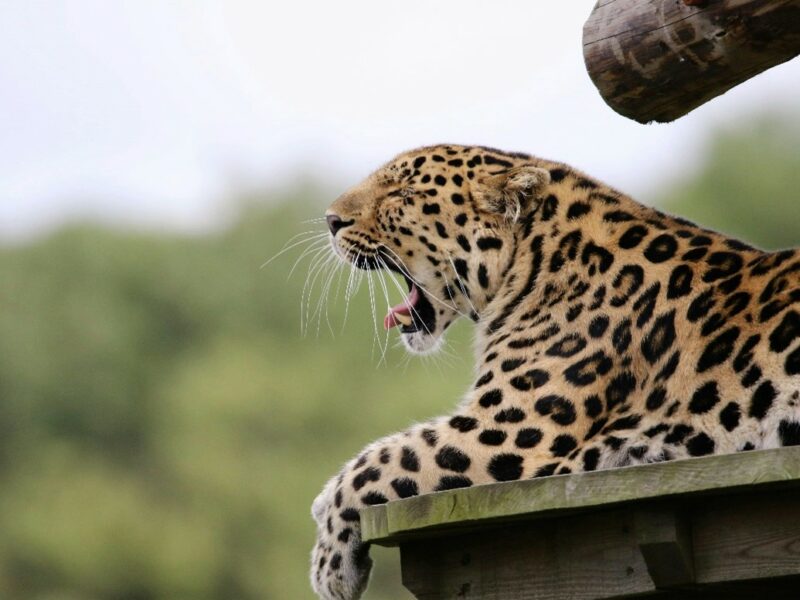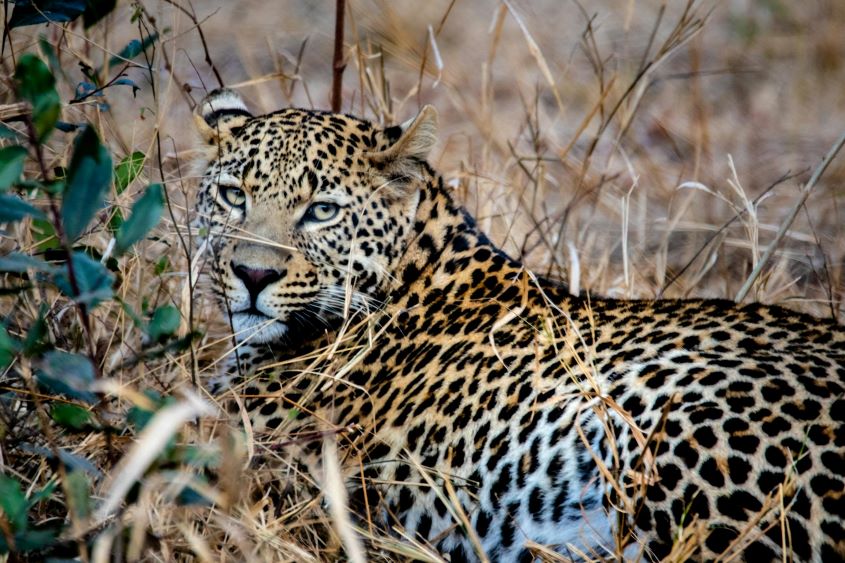Hunting leopard in Africa is a game hunting safari that many hunters dream of, and few can achieve and is subject to several reasons. Firstly, the African leopard is a shy and elusive animal, as well as one of the most effective hunters worldwide. This makes it an extremely alert animal and very difficult to hunt on a safari. Secondly, hunting leopard in Africa can be a costly activity as they are one of the most expensive African big game hunting species on offer. Lastly, leopards are exceptionally dangerous creatures and are not to be underestimated. They are part of the Big 5, which singles out the most dangerous African animals to hunt and they are firmly on the list! To many hunters, the leopard may be the most dangerous of all big game hunting species available. Leopard hunting in Namibia offers the opportunity for one to achieve their dream game hunting safari.
[DYNAMIC-BLOGTABLEOFCONTENT]
Hunting Methods for Leopard Hunting in Africa
Leopard hunting in Namibia is normally done by baiting. Namibia, Botswana, Mozambique, and Zimbabwe legally allow and practice game hunting with hounds. Essentially the process is very similar to hunting mountain lions in the United States of America. A group of trained and experienced hounds are put onto the scent of a huntable trophy-sized leopard, and then they follow the scent and tracks until they find the target, in this case the leopard. This is, however, exceptionally dangerous as a leopard will not hesitate to attack when wounded or agitated. Usually, the cat seeks refuge in a tree before thinks get too hairy, and then the hunter can make a clean kill with ease.
There is a huge difference in the hunting styles and methods for leopards in Namibia. The method of the hunt should be determined by how the client would like to hunt his leopard, but it also depends on what the outfitter is able to execute as a method, as many outfitters and professional hunters will not keep so many hunting hounds at once for such purposes.
When hunting leopard in Africa, you will always be targeting this African big game hunting species using the baiting method, unless you are hunting in Namibia, Botswana, Mozambique, and Zimbabwe, of course, as mentioned previously.

Things to Consider When Baiting and Hunting Leopard in Africa
Baiting of a leopard is somewhat of an art in the field of hunting, as there are many things to consider when preparing to bait.
Seasonality is a Factor
Firstly, the season in which the baiting is done is important. In many areas game hunting can be done all year round but is mostly done in the dry season. The same applies for leopard baiting. Yes, they can be baited in the wet season, but success rates are much higher in the dry periods. The best months to bait are towards the end of winter, ideally between July and September, as this is when leopards will be searching for opportunistic meals.
Fresh Signs of Leopards in the Area
The next factor of baiting is finding a fresh leopard sign. Generally, professional hunters look for signs such as tracks, faeces, and scratch marks on trees, as well as fresh kills if they are found. Taking these indicators into account, one should be able to tell the sex and approximate size of the leopard, determining if it is the ideal trophy to hunt. Once locating the correct leopard’s territory is located, essentially any bait can be used. Most of the time the hunter will shoot an animal such as impala or kudu and a portion of the animal will be used as bait. However, other large game animals such as Cape buffalo and hippo can also be used as bait, as leopards are opportunistic feeders and are not too fussy.
Bait Preparation when Hunting Leopard in Africa
Preparing the bait site is extremely important, a tree of the correct characteristic should be used, one which has an almost horizontal limb able to hold the weight of at least 300 pounds, accounting for the weight of the leopard and the bait, and the person who needs to climb the tree to put the bait up before the hunt. When locating a tree, ensure that a hide or blind can be erected to shoot from. The blind should be at least 50 yards downwind from the blind, ensuring that the leopard does not pick up the scent of the hunters.
The hide should be constructed from natural materials such as wooden poles, grass, and branches, to blend in with the environment. The leopard should first be baited, once the leopard is regularly feeding the blind should then be built. It can take up to a month of baiting in numerous sites within the leopard’s territory before the cat visits the site, as leopards are exceptionally intelligent and wary.
Big old tomcats are even more difficult than the average leopard. They feed irregularly and are unpredictable, normally never feeding with a specific routine. These old and smart leopards are the cats which should be targeted, as hunting them would allow for new and younger cats to move in and diversify the bloodline in that area. It is, however, not that easy or straightforward.

Rifle Calibre and Shot Placement When Hunting Leopard in Africa
The leopard is the smallest of the big game animals in Africa, which makes it relatively easy to shoot and kill efficiently. It’s the creature’s intelligence which makes the hunt a challenging one! With correct shot placement, a full-grown 200-pound leopard can be killed with any 30-calibre rifle, perhaps an even smaller caliber. However, many professional hunters will recommend the hunter use at least a .375 caliber as the leopard is still considered a dangerous game, and if wounded the situation can escalate in no time whatsoever. Of course, the cat can still be wounded with a rifle of this caliber, which is why shot placement, as always is extremely important for leopard hunting in Namibia. The heart is the target area to place the bullet and resides slightly behind the shoulder one-third of the way up on the body when the cat is standing broadside. This is exactly where the hunter should aim. However, in many situations the cat may be sitting down or standing on its back legs when feeding, these body positions do not provide the best opportunity for a well-placed shot. The hunter should ideally take the shot when the leopard is standing flat-footed on all four limbs with its body facing broadside.
A young leopard, not the ideal trophy to take while big game hunting.
What Does Leopard Hunting in Namibia Cost?
A leopard hunt is generally between 14-21 days, and as with all big game hunting trips, the price of the entire hunt will vary based on a few specific factors. The trophy fees make up a large portion of the hunting expense, as well as what the specific outfitter chooses to charge for the leopard hunt.
The expenses do not end here unfortunately, if the hunter chooses to preserve their trophy with a stuffed mount, they will need to have the skin and skull treated accordingly, transported to a taxidermist, and then shipped out of Africa to the hunter’s home, all of which comes at additional fees.
Leopard hunting in Namibia does, however, make this procedure slightly less complicated as many hunting outfitters provide the service of treating the skull and cape, arranging transport to the taxidermist, and then overseeing the transport procedures of shipping the trophy. All while staying in touch with the client who hunted the leopard and keeping them updated throughout the process. A hunter can expect a leopard hunt of roughly 14 days to cost anywhere between $18,000 and $30,000, however, this is only subject to leopard hunting in Namibia.
As for hunting leopard in Africa as a whole, the price begins to vary much more, usually in an increased price.

What is the Trophy Free for Leopard Hunting in Namibia?
The trophy fee of any game animal is only a portion of the total price to hunt the animal, this portion usually goes to the hunting outfitter or landowner. Hunting in Namibia provides an unforgettable experience, often unforgettable because of the exasperated trophy fees!
However, these trophy fees are undeniably necessary for any game hunting safari in Namibia, and all other areas. The hunting outfitter or landowner also needs to take their slice of the pie, as it is their livelihood and source of income. Much of the fees charged for any hunting safari get put back into the conservation system, whether it be to feed during the dry months, fix fences to protect the animals, or maintain roads on the ranch or hunting concession, the money is certainly not wasted. A hunter can expect a trophy fee for a leopard to be between US$7,000 to US$9,000 on average.
How much does a Hunting Safari in Namibia Cost?
A big game hunting safari is usually one of the most expensive trips, with a few other exceptions of rare game animals. A hunting safari in Namibia offers many different species for the hunter, all species for big game hunting, as well as many Africa plains game species and certain speciality animal hunts. The price of a hunting safari in Namibia will vary depending on which species are targeted. A Cape buffalo hunt in Namibia will generally be between $8,000 and $15,000, and an African elephant can go for anywhere between $10,000 and $40,000, depending on trophy size and whether the ivory is exportable or not. A rhino hunting safari in Namibia will generally be around $30,000, specifically for a white rhino trophy. Black rhinos are much more expensive to hunt, with very few outfitters having access or the permits to hunt a black rhino, a price cannot be predetermined as a result thereof.
Leopards may range anywhere between $18,000 and $30,000 in certain cases. Lions hunting safaris in Namibia are priced very closely with leopards. In terms of Africa plains game hunting species, there is no specific price as there are many different species which hold different biological values.
In general terms, a plains game package of five species is sold for between $5,000 and $10,000. Hunting in Namibia is an experience which will likely not be a cheap one but can be very affordable when budgeted for and when arranged with a game hunting company that has your best interests in mind, not just fattening their pockets for profit.
The hunting industry generates hundreds of millions of dollars each year and can be considered an excellent industry to pursue a career in for nature lovers and avid outdoorsmen. So, try and book your game hunting safari with someone who shares your ideologies and ethics, someone who may provide the most memorable and exciting experience.
How many Leopards are left in Namibia?
To many people’s surprise, the leopard population in Namibia is not struggling at all. As a result of controlled leopard hunting in Namibia, their numbers are gradually increasing. This is solely the result of controlled hunting as a conservation effort. The only risk the leopard population faces is habitat loss and habitat fragmentation, which is a result of expanding urban areas. The estimated population of leopards in Namibia is roughly 12,000, based on the latest census survey conducted in 2019.
To date, we can expect the leopard population to have increased significantly as a result of hunting in Namibia. Leopards are very effective in reproducing, theoretically, one leopardess can produce up to three litters per annum, with the possibility of up to three cubs in a litter. This however is unlikely, once a female gives birth her cubs stay by her side until approximately 18 months and she will not breed in this period, and often only one cub will survive.
Once the cub reaches 18 months and the mother is satisfied it can survive, she will abandon the cub. The female will leave this territory to her cub as she goes off to find a new one as well as a new mate, where the whole cycle will start over. However, once separation between the mother and cub occurs, they are no longer family, and they are now rivals. If these two cross paths again they will fight, and one will likely be killed. This is simply the nature of the leopard and another reason why merciless Mother Nature is a perfectly functioning, brutal system.
Enjoy a Leopard Hunting Safari in Namibia
Leopard hunting in Namibia is a great hunting adventure and a dream African game hunting safari for many international hunting enthusiasts. It requires, patience, skills, expertise, and the ability to stay in the game as your cunning prey provides a great hunting challenge. Bring your A-game when hunting in Namibia and enjoy a fantastic leopard hunting experience.
Read more about Namibia and hunting safaris in Africa.
Author: K.C. van Wyk
Conservationist & Professional Hunter
